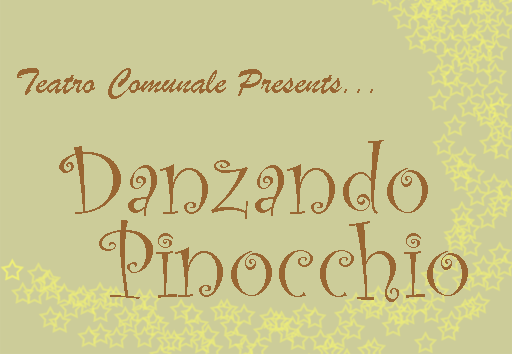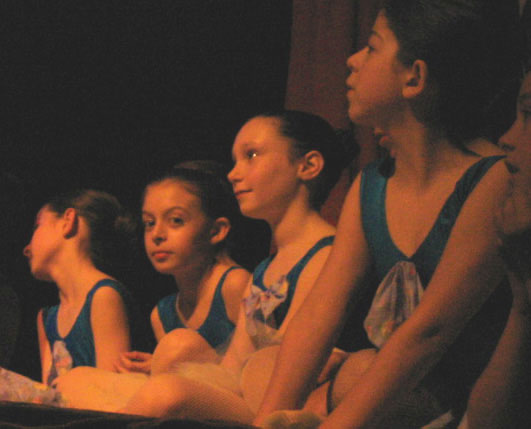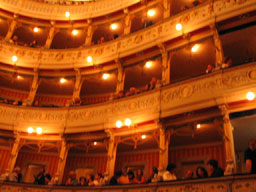| |
|
|
|
|
 |
For
Other Works
By
Julie Dise
Journal Entry
Photo Essay
To View Video Click Here
|
|
Through a dark, twisted hallway,
I brush past cold, brick walls and enter the side door.
I pass by doorways that all lead to one place.
I follow the sound: an orchestra of instruments flowing from a stereo.
I continue, close to the thumping of feet, and there it is.
|

The Marionette, Pinocchio, is led on stage as the girls dance all around. |
 |
Inside the Teatro Comunale in Cagli stands a grand stage.
This display for talent faces the red velvet seats of the first several rows.
Previous to Teatro Comunale, Cagli's original theater desperately needed an
enlargement and restoration, so the town decided a new location and structure would
be more efficient. The new theater was completed on December 11, 1876,
after thirteen-and-a-half years of discussion, planning and construction.
Originally, the three orders of box seating that form a horseshoe shape from floor
to ceiling were occupied according to social status and financial contribution.
Thirty years ago, however, the Cagli town hall attained ownership of the theater,
and still holds it today. As I walk down the aisle, I consider that the floor below
me is complete and no longer doubles as a dance floor.
Although the ceiling's unique design allows
it to open and reel in the
chandelier dangling above, I look up to see that the fixture remains as the lights dim.
The stage's historic curtain, which features a painting of Frederick the First (Barbarossa)
and a local
| general, with Mt. Petrano in the distance, is already unfurled,
its folds concealing this beautiful scene.
Then, subtly, almost indistinguishable in their
completely brown leotards, a few adult women start a graceful dance.
At this moment, the mood suddenly lightens as child ballerinas, some as young as three,
run on stage in pink leotards with tutus. Dancing to one of the few songs by Aubry of
the original Pinocchio music, the notes hum from the surround sound of the stereo in the theater.
At this time, the true heart of Pinocchio is revealed as Marzio Zoffoli inches behind
his marionette, hands twisting the strings, and makes his first entrance on stage.
This miniature, wooden figure of a boy instantly grabs the audience's attention.
Fellini, the famous
Italian film director,
aided the De Marchi brothers in designing the leather and wood creation
made specifically for this performance in Cagli. This marionette's German
eyes move, seemingly alive, and its beautiful design is a success.
Due to the marionette's unique height and weight, Marzio needed an entire week
solely to learn to control this particular puppet. Marzio's attachment grew;
in fact, he would pay 6,000 Euro following the performance to keep this particular marionette.
Circling and dancing with Pinocchio, the ballerinas of Belinde Marini's dance school enact
this famous Italian fairy tale of a puppet that comes to life
as a real boy.
|

Young ballerinas wait for their turn in the spotlight
| |
| |
|
Girls travel as far as 40 kilometers to Cagli to
dance under the direction of Belinde, owner and founder of Movimento e Fantasia dance school.
Ranging from amateur to experienced, three years old to forty, about eighty of
Belinde's dancers have worked to perfect this ballet over a full five months.
Spinning with rainbow-colored ribbons tied to a ring, more mature dancers dressed
in multicolored costumes twirl across the stage. Having run this dance school
for twelve years, Belinde is pleased that Pinocchio is a sold-out performance.
The skill of the dancers and the support of their friends and family at this annual
ballet is encouraging. With the assistance of her co-choreographers, Mayra Collazo Ortiz,
Barbara Conti and Philippe Lesdema, dances ranging from classic style to contemporary
funk are scattered throughout the ballet and choreographed to music as diverse as
American rap and hip hop.
|
 |
 Inside Cagli's beautiful Teatro Comunale Inside Cagli's beautiful Teatro Comunale |
 |

Talented dancers move to the beat of fast paced American music |
Rehearsals for "Danzando Pinocchio" had ranged from one to six hours per week,
as determined by the difficulty level of the dances and experience of the dancers.
Days later, with the Pinocchio performance now in the past, Belinde is still busy
and popular as she sits before me dressed in blue sweats, a white tank top and red
sneakers, straight from dance class. Distributing professional photos from
Pinocchio's performance, Belinde is thrilled to discuss the success of the show.
She raves that this was a one-time performance and only certain dances will be
repeated in a nearby town on August 16th. Belinde hopes her ballet's rendition of
this always popular fairy tale will be as successful as the movie was in Italy this year.
|
| |
|
The universal language of music and dance was evident when a song
from Moulin Rouge, also incorporated in Pinocchio, had blared from the speakers,
and young adult dancers sped up the pace to fit the songs.
Since Belinde had chosen music styles born in the U.S., like American rap, to fit
the story's mood, the show had featured fast, funky, hip hop dances, as well as several songs
from the original Pinocchio. Learning English in school, many of the girls were excited to
dance to American songs by artists such as Madonna and Christina Aguilera and to sing the lyrics.
The swear words present in some of these songs were commonly understood by most of the youth,
but, luckily, Belinde commented laughing, the parents probably did not understand.
As the interview ended, the performance stayed with me as clearly as that evening a few days e
arlier. . .
It's the finale, and young girls fill
the stage in blue costumes, still excited despite the exhaustion they must
feel after two hours of dancing. As they dance "The Whale," music by Aubry again fills the air.
Their graceful moves are complemented by a large, beautifully crafted and artfully designed
wooden whale. This blue whale, well remembered from the fairy tale of Pinocchio,
is now visible as the girls dance, making the head and tail glide across the stage.
Slightly different from the traditional story, this show ends as Pinocchio and his creator
Geppetto are ejected from the whale's mouth and Pinocchio appears as a real boy.
In one night, Movimento e Fantasia had brought the
community of Cagli together through art, music and dancing. No one was too old or too
young to be a part of this performance, a modern interpretation of an age-old tale.
Spectators enjoyed what almost seemed to be an entirely new work of the theater,
while still able to be part of the Italian tradition that is Pinocchio.
As dancers communed on stage to bow, their smiles of satisfaction and the audience's
applause fully confirmed the show's success.
|

The entire colorful cast after a successful performance
|
Story:
Julie Dise Web Design: Caroline Douglas
Photography: Julie Dise Video: Nicole Scariano
Works Cited: Arseni, Carlo. Immagine di Cagli. Grafiche Carlosci: Cortona.
1989 |





 Inside Cagli's beautiful Teatro Comunale
Inside Cagli's beautiful Teatro Comunale

